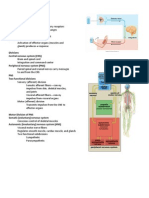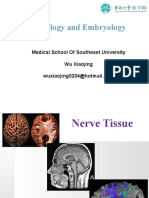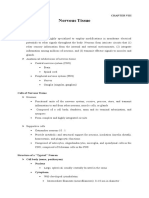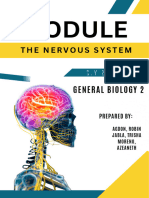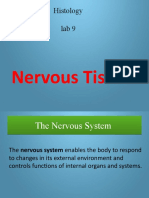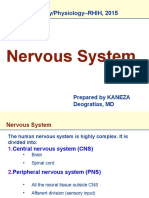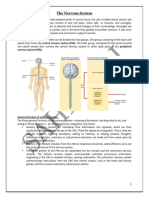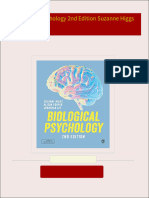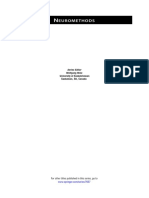0 ratings0% found this document useful (0 votes)
0 viewsANAPHY CHAPTER 7
ANAPHY CHAPTER 7
Uploaded by
Jeshea RosalesChapter 7 discusses the nervous system's structure and function, highlighting its role in regulating body functions through electrical impulses and maintaining homeostasis. It details the organization of the nervous system into the CNS and PNS, the types of neurons and supporting cells, and the physiological properties of nerve impulses. Additionally, it covers various brain functions, disorders, and protective mechanisms of the CNS.
Copyright:
© All Rights Reserved
Available Formats
Download as PDF, TXT or read online from Scribd
ANAPHY CHAPTER 7
ANAPHY CHAPTER 7
Uploaded by
Jeshea Rosales0 ratings0% found this document useful (0 votes)
0 views12 pagesChapter 7 discusses the nervous system's structure and function, highlighting its role in regulating body functions through electrical impulses and maintaining homeostasis. It details the organization of the nervous system into the CNS and PNS, the types of neurons and supporting cells, and the physiological properties of nerve impulses. Additionally, it covers various brain functions, disorders, and protective mechanisms of the CNS.
Original Description:
Practice your skills.
Copyright
© © All Rights Reserved
Available Formats
PDF, TXT or read online from Scribd
Share this document
Did you find this document useful?
Is this content inappropriate?
Chapter 7 discusses the nervous system's structure and function, highlighting its role in regulating body functions through electrical impulses and maintaining homeostasis. It details the organization of the nervous system into the CNS and PNS, the types of neurons and supporting cells, and the physiological properties of nerve impulses. Additionally, it covers various brain functions, disorders, and protective mechanisms of the CNS.
Copyright:
© All Rights Reserved
Available Formats
Download as PDF, TXT or read online from Scribd
Download as pdf or txt
0 ratings0% found this document useful (0 votes)
0 views12 pagesANAPHY CHAPTER 7
ANAPHY CHAPTER 7
Uploaded by
Jeshea RosalesChapter 7 discusses the nervous system's structure and function, highlighting its role in regulating body functions through electrical impulses and maintaining homeostasis. It details the organization of the nervous system into the CNS and PNS, the types of neurons and supporting cells, and the physiological properties of nerve impulses. Additionally, it covers various brain functions, disorders, and protective mechanisms of the CNS.
Copyright:
© All Rights Reserved
Available Formats
Download as PDF, TXT or read online from Scribd
Download as pdf or txt
You are on page 1of 12
CHAPTER 7: NERVOUS SYSTEM 2.
Motor Division: Carries motor commands from the CNS
Nervous System as Master Control: The nervous system to the body.
regulates all body functions, from thoughts to actions. a. Somatic Nervous System: Controls skeletal muscles
Electrical Impulses: The nervous system communicates (voluntary).
using rapid electrical signals, allowing for immediate b. Autonomic Nervous System (ANS): Controls smooth
responses. muscle, cardiac muscle, and glands (involuntary).
Homeostasis: The nervous system works with the
endocrine system to maintain a stable internal
environment.
Three Overlapping Functions: The nervous system has
three primary functions: sensory input, integration, and
motor output.
Feedback Loop: The nervous system operates like a
feedback loop, receiving sensory information, processing
it, and producing a response.
NERVOUS TISSUE: STRUCTURE AND FUNCTION
- nervous tissue is made up of just two principal types of
Example: Driving and Responding to a Red Light cells—supporting cells and neurons
Sensory Input: You see a red light ahead (receptor). SUPPORTING CELLS (NEUROGLIA)
Integration: Your brain processes the information, Neuroglia: Supporting cells of the nervous system.
recognizing that red means "stop." Functions: Support, insulate, and protect neurons.
Motor Output: Your nervous system sends a signal to Types of Neuroglia: Astrocytes, microglia, ependymal
your leg muscles. cells, oligodendrocytes (CNS), Schwann cells, and satellite
Response: Your foot applies the brake. cells (PNS).
Additional Insights:
Parallel Processing: The nervous system can handle
multiple tasks simultaneously, such as driving, conversing,
and reacting to unexpected stimuli.
Adaptation: The nervous system can adapt to changing
conditions, allowing for learning and memory.
Complexity: The human nervous system is incredibly
complex, with billions of neurons interconnected in
intricate networks.
ORGANIZATION OF THE NERVOUS SYSTEM
Structural Classification: Divides the nervous system into the
central nervous system (CNS) and peripheral nervous system
(PNS).
1. Central Nervous System (CNS): Consists of the brain and
spinal cord, serving as the command center.
2. Peripheral Nervous System (PNS): Includes nerves
connecting the CNS to the rest of the body.
Functional Classification: Divides the PNS into the sensory
division and motor division. Supporting Cells in the Central Nervous System (CNS):
1. Sensory Division: Carries sensory information from the a. Astrocytes
body to the CNS. - Star-shaped cells that provide structural support and
nutrient supply to neurons.
- Form a barrier between blood capillaries and neurons. Tracts: Bundles of nerve fibers (neuron processes)
- Help maintain the chemical environment of the brain. running through the CNS.
b. Microglia Nerves: Bundles of nerve fibers (neuron processes) in the
- Phagocytic cells that remove debris and dead cells. peripheral nervous system (PNS).
c. Ependymal Cells White Matter: Regions of the CNS containing myelinated
- Line the central cavities of the brain and spinal cord. nerve fibers.
- Help circulate cerebrospinal fluid. Gray Matter: Regions of the CNS containing unmyelinated
d. Oligodendrocytes nerve fibers and cell bodies.
- Produce myelin sheaths around nerve fibers in the CNS. STRUCTURE:
Supporting Cells in the Peripheral Nervous System (PNS): Cell Body: Contains the nucleus, Nissl bodies, and
a. Schwann Cells neurofibrils.
- Produce myelin sheaths around nerve fibers in the PNS. Dendrites: Branch-like extensions that receive incoming
b. Satellite Cells signals.
- Provide protective cushioning for peripheral neuron cell Axon: Long, slender process that transmits nerve
bodies. impulses away from the cell body.
Key Differences Between Neuroglia and Neurons: Axon Hillock: Cone-shaped region where the axon
Function: Neuroglia support and protect neurons, while originates.
neurons transmit nerve impulses. Collateral Branches: Branches of the axon.
Divisibility: Neuroglia can divide, while most neurons Axon Terminal: The end of the axon, containing synaptic
cannot. vesicles filled with neurotransmitters.
NERVE CELL (NEURONS) Synaptic Cleft: The gap between the axon terminal and
Neurons: Specialized cells that transmit nerve impulses. the target cell.
Structure: Cell body, dendrites, and axon. Neurilemma: Outer layer of the Schwann cell surrounding
Myelin Sheath: Insulating layer around axons. the myelin sheath.
Synapses: Junctions between neurons. Nodes of Ranvier: Gaps in the myelin sheath where the
Functional Classification: Sensory, motor, and association axon is exposed.
neurons.
Structural Classification: Multipolar, bipolar, and unipolar
neurons.
Neurons: The Functional Cells of Nervous Tissue
ANATOMY:
Nissl Bodies: Clusters of rough endoplasmic reticulum
(RER) in the cell body, responsible for protein synthesis.
Neurofibrils: Intermediate filaments that maintain cell
shape and provide structural support.
Processes: Extensions of the neuron, including dendrites
and axons.
Fibers: Another term for processes.
Dendrites: Branch-like extensions that receive incoming
signals.
Axons: Long, slender processes that transmit nerve
impulses away from the cell body.
Axon Hillock: Cone-shaped region of the cell body where
the axon originates.
Collateral Branch: A branch of an axon.
Axon Terminal: The end of an axon, containing synaptic
vesicles filled with neurotransmitters.
Neurotransmitters: Chemical messengers released into
the synaptic cleft.
Synaptic Cleft: The gap between the axon terminal of one
neuron and the dendrite or cell body of another.
Neurilemma: Outer layer of the Schwann cell surrounding
the myelin sheath.
Nodes of Ranvier: Gaps in the myelin sheath where the
axon is exposed.
Ganglia: Clusters of neuron cell bodies outside the central
nervous system (CNS).
Structural Classification:
Multipolar: Many dendrites and one axon (most
common).
Bipolar: One dendrite and one axon (found in special
sense organs).
Unipolar: Single process that divides into dendrites and
axon (sensory neurons).
MULTIPLE SCLEROSIS (MS): An autoimmune disease that
damages nerves, causing symptoms like vision problems and
muscle weakness. There's no cure, but treatments can help.
FUNCTIONAL CLASSIFICATION:
Sensory Neurons (Afferent Neurons): Transmit impulses
from sensory receptors (cutaneous sense organs-sensory
receptors in the skin, proprioceptors-sensory receptors in
muscles, tendons, and joints that detect stretch or
tension) to the CNS.
Motor Neurons (Efferent Neurons): Transmit impulses
from the CNS to effectors (muscles and glands).
Association Neurons (Interneurons): Connect sensory
and motor neurons.
PHYSIOLOGY: NERVE IMPULSES
Physiological Properties:
Irritability: The ability to respond to stimuli and generate
nerve impulses.
Conductivity: The ability to transmit nerve impulses.
Electrical Conditions of a Resting Neuron:
Polarized Membrane: The inside of the neuron is
negatively charged compared to the outside.
Ion Distribution: Potassium ions (K+) are higher inside,
while sodium ions (Na+) are higher outside.
Generation of a Nerve Impulse:
Stimulus: A stimulus (e.g., neurotransmitter, light, sound)
triggers depolarization.
Sodium Influx: Sodium ions rush into the neuron, causing
depolarization.
Action Potential: If the depolarization reaches threshold,
an action potential is generated.
Repolarization: Potassium ions flow out of the neuron,
restoring the resting potential.
Sodium-Potassium Pump: Restores the original ion
concentrations.
Conduction of a Nerve Impulse:
Saltatory Conduction: In myelinated fibers, the nerve
impulse jumps from node to node, increasing speed.
(saltare = to dance or leap)
Synaptic Transmission:
Neurotransmitter Release: When the action potential
reaches the axon terminal, neurotransmitters are
released into the synaptic cleft.
Binding: Neurotransmitters bind to receptors on the
postsynaptic neuron.
Excitatory or Inhibitory Effects: Neurotransmitters can
either excite or inhibit the postsynaptic neuron.
Reflexes:
Rapid, Involuntary Responses: Reflexes are automatic
responses to stimuli.
Reflex Arc: The neural pathway involved in a reflex,
typically involving sensory neurons, interneurons, and
motor neurons.
Types of Reflexes: Somatic reflexes (skeletal muscles) and
autonomic reflexes (smooth muscles, cardiac muscle,
glands).
Factors That Can Impair the Conduction of Nerve Impulses
Sedatives and Anesthetics: These drugs can block nerve
impulses by altering the permeability of the cell
membrane to ions, particularly sodium ions. This prevents
the influx of sodium ions, which is necessary for the
generation of an action potential.
Cold and Continuous Pressure: These conditions can
hinder impulse conduction by interrupting blood
circulation. This reduces the delivery of oxygen and
nutrients to neurons, which are essential for their proper
functioning.
o Motor Homunculus: A map of the body's
representation in the primary motor area.
o Broca's Area: Involved in speech production.
Higher-Order Functions:
o Frontal Lobe: Involved in intellectual reasoning,
social behavior, and language comprehension.
o Temporal Lobe: Involved in memory and language
comprehension.
o Parietal Lobe: Involved in spatial awareness and
sensory integration.
o Occipital Lobe: Involved in visual processing.
Cerebral White Matter:
o Corpus Callosum: Connects the two cerebral
hemispheres.
o Association Fibers: Connect areas within a
hemisphere.
o Projection Fibers: Connect the cerebrum with lower
brain centers.
Basal Nuclei:
o Function: Help regulate voluntary motor activities.
o Internal Capsule: A bundle of projection fibers
passing through the basal nuclei.
CENTRAL NERVOUS SYSTEM
Functional Anatomy of the Brain
Cerebral Hemispheres (cerebrum): The largest part of the
brain, responsible for higher-order functions.
Gyri and Sulci: Ridges and grooves on the surface of the
cerebral hemispheres.
Lobes: Divisions of the cerebral hemispheres (frontal,
parietal, temporal, occipital).
Cerebral Cortex: The outer layer of gray matter,
responsible for most brain functions.
White Matter: The internal region of the cerebral
hemispheres, consisting of myelinated nerve fibers.
Basal Nuclei: Gray matter structures deep within the
white matter, involved in motor control.
Cerebral Hemispheres: The Seat of Higher-Order Functions
Structure:
Gyri and Sulci: Increase the surface area of the brain.
Lobes: Frontal, parietal, temporal, and occipital lobes.
Regions:
Cerebral Cortex: Gray matter responsible for higher-order
functions.
Cerebral White Matter: Primarily composed of
myelinated nerve fibers.
Basal Nuclei: Gray matter structures involved in motor
control.
Functions of the Cerebral Cortex:
Sensory Functions:
o Primary Somatic Sensory Area: Receives and
interprets sensory information from the body (except
for special senses).
o Sensory Homunculus: A map of the body's
representation in the primary somatic sensory area.
o Special Senses: Visual, auditory, and olfactory areas.
Motor Functions:
o Primary Motor Area: Controls voluntary movement
of skeletal muscles.
HUNTINGTON'S DISEASE: A genetic disorder that causes
progressive brain damage, leading to uncontrolled
movements, cognitive decline, and psychiatric problems.
PARKINSON'S DISEASE: A neurodegenerative disorder
characterized by tremors, rigidity, slow movements, and
difficulty walking.
Diencephalon
Thalamus: A relay station for sensory impulses, involved
in crude recognition of sensations.
Hypothalamus: Regulates body temperature, water
balance, metabolism, and drives/emotions.
Epithalamus: Contains the pineal gland and choroid
plexus.
Brainstem
Midbrain: Contains the cerebral aqueduct, cerebral
peduncles, and corpora quadrigemina.
Pons: Involved in breathing control.
Medulla Oblongata: Controls vital functions like heart
rate, blood pressure, breathing, swallowing, and
vomiting.
Reticular Formation: Involved in motor control of visceral
organs and consciousness.
o Reticular Activating System (RAS): Plays a crucial role
in arousal, attention, and consciousness. It filters
sensory information and helps regulate the sleep-
wake cycle.
Cerebellum
Key Functions:
Motor Coordination: Ensures smooth and coordinated
movements.
Balance: Maintains balance and posture.
Fine Motor Control: Regulates precise movements.
Muscle Tone: Maintains appropriate muscle tension.
Structure:
Cerebellar Hemispheres: Two lateral hemispheres.
Vermis: A central, midline region connecting the
hemispheres.
Cerebellar Cortex: Outer layer of gray matter.
Cerebellar Nuclei: Deep gray matter structures.
Inputs and Outputs:
Inputs: Receives information from the cerebral cortex,
brainstem, and sensory receptors (proprioceptors,
vestibular system).
Outputs: Sends information to the cerebral cortex and
brainstem to modify motor commands.
Role in Motor Control:
Error Correction: Compares intended movements with
actual movements and corrects errors.
Timing: Ensures precise timing of muscle contractions.
Sequencing: Coordinates complex movements involving
multiple muscle groups.
Clinical Significance:
Damage to the cerebellum: Can lead to ataxia
(incoordination), tremors, difficulty maintaining balance,
and impaired speech.
Production: Produced by the choroid plexuses in the
ventricles.
Circulation: Flows through the ventricles and
subarachnoid space.
Functions: Cushions and protects the brain and spinal
cord, maintains a stable environment.
Absorption: Absorbed into the venous blood through
arachnoid granulations.
ATAXIA: A condition caused by damage to the cerebellum,
affecting movement and balance. Symptoms include
clumsiness, difficulty walking, and tremors.
PROTECTION OF THE CENTRAL NERVOUS SYSTEM
1. Meninges
Dura Mater: The outermost layer, tough and fibrous.
Arachnoid Mater: Middle layer, web-like.
Pia Mater: Innermost layer, delicate and tightly adhered
to the brain and spinal cord.
Subarachnoid Space: Contains cerebrospinal fluid (CSF).
HYDROCEPHALUS: A condition where cerebrospinal fluid (CSF)
accumulates in the brain, leading to increased pressure.
3. Blood-Brain Barrier:
Function: Protects the brain from harmful substances in
the blood.
Structure: Tight junctions between capillary endothelial
cells.
Permeability: Highly selective, allowing only certain
substances to pass through.
Importance: Maintains a stable environment for optimal
brain function.
BRAIN DYSFUNCTIONS
TRAUMATIC BRAIN INJURIES (TBIS)
Causes: Accidents, falls, sports injuries, violence
Types: Concussions, contusions, intracranial hemorrhage,
cerebral edema
Symptoms: Dizziness, loss of consciousness, impaired
cognitive function, motor deficits, sensory disturbances,
emotional problems
MENINGITIS: Inflammation of the meninges, the protective CEREBROVASCULAR ACCIDENTS (CVAS)
membranes surrounding the brain and spinal cord. Causes: Blood clots, ruptured blood vessels
ENCEPHALITIS: Inflammation of the brain tissue, often caused Symptoms: Weakness or numbness on one side of the
by untreated meningitis. body, difficulty speaking or understanding speech,
2. Cerebrospinal Fluid (CSF): sudden vision changes, severe headache
Long-term effects: Cognitive impairments, motor deficits,
sensory disturbances, emotional problems
BRAIN TUMORS: Can cause a variety of symptoms, including
headaches, seizures, and changes in personality.
NEURODEGENERATIVE DISEASES: Conditions that cause
progressive damage to brain cells, such as Alzheimer's disease
and Parkinson's disease.
SPINAL CORD
Structure: Cylindrical structure extending from the brain
stem to the lumbar region.
Functions: Provides a two-way communication pathway
between the brain and body and serves as a reflex center.
Meninges: Protected by the same meninges as the brain.
Spinal Nerves: 31 pairs of nerves arising from the spinal
cord.
Gray Matter: Contains interneurons (dorsal horns) and
motor neurons (ventral horns).
White Matter: Contains ascending (sensory) and
descending (motor) tracts.
Structure and Function of the Spinal Cord:
Location: Extends from the foramen magnum to the first
or second lumbar vertebra.
Meninges: Covered by the dura mater, arachnoid mater,
and pia mater.
Spinal Nerves: 31 pairs of spinal nerves emerge from the
spinal cord.
Gray Matter:
o Dorsal Horns: Contain interneurons.
o Ventral Horns: Contain cell bodies of motor neurons.
o Central Canal: Contains cerebrospinal fluid (CSF).
White Matter:
o Dorsal Column: Ascending tracts carrying sensory
information to the brain.
o Lateral Column: Contains both ascending and
descending tracts.
o Ventral Column: Contains both ascending and
descending tracts.
Functions:
Conduction Pathway: Provides a two-way communication
pathway between the brain and body.
Reflex Center: Mediates spinal reflexes.
FLACCID PARALYSIS: Results from damage to the ventral root,
which carries motor impulses to muscles; muscle atrophy
SPASTIC PARALYSIS: Results from damage to the spinal cord,
causing involuntary muscle movements and loss of sensation.
QUADRIPLEGIA: Paralysis of all four limbs.
PARAPLEGIA: Paralysis of the legs.
The Terrible Three
ALZHEIMER'S DISEASE (AD): Memory loss, disorientation,
cognitive decline.
PARKINSON'S DISEASE: Tremors, rigidity, slow movements,
difficulty walking. PERIPHERAL NERVOUS SYSTEM
HUNTINGTON'S DISEASE: Jerky movements, mental Structure of a Nerve
deterioration. Endoneurium: Connective tissue sheath surrounding
individual nerve fibers.
Perineurium: Connective tissue sheath surrounding
groups of fibers (fascicles).
Epineurium: Tough outer connective tissue sheath
surrounding the entire nerve.
Classification of Nerves
Sensory (Afferent) Nerves: Carry impulses toward the
CNS.
Motor (Efferent) Nerves: Carry impulses from the CNS to
effectors.
Mixed Nerves: Contain both sensory and motor fibers.
CRANIAL NERVES
12 Pairs: Serve the head and neck, except for the vagus
nerve.
Functions: Vary widely, including sensory, motor, and
mixed functions.
Testing: Specific tests are used to evaluate cranial nerve
function.
SPINAL NERVES
31 Pairs: Formed by the combination of dorsal and
ventral roots.
Naming: Named according to the region of the spinal cord
from which they arise.
Dorsal and Ventral Rami: Each spinal nerve divides into a
dorsal ramus (serving the posterior body) and a ventral
ramus (serving the anterior and lateral body).
Intercostal Nerves: Ventral rami of spinal nerves T1-T12,
supplying the intercostal muscles and skin.
Nerve Plexuses: Networks of ventral rami serving the
limbs.
Control:
o Somatic: Voluntary
o Autonomic: Involuntary
ANATOMY OF THE PARASYMPATHETIC DIVISION
Preganglionic Neurons: Located in the brainstem and
sacral spinal cord.
Cranial Nerves: III, VII, IX, and X.
Pelvic Splanchnic Nerves: Sacral outflow.
Terminal Ganglia: Located near or on the target organs.
ANATOMY OF THE SYMPATHETIC DIVISION:
Preganglionic Neurons: Located in the thoracic and
lumbar spinal cord.
Sympathetic Trunk: Chain of ganglia running along the
vertebral column.
Collateral Ganglia: Celiac, superior mesenteric, and
inferior mesenteric ganglia.
AUTONOMIC NERVOUS SYSTEM
Autonomic Nervous System (ANS): Controls involuntary
bodily functions.
Divisions: Sympathetic and parasympathetic divisions.
Effector Organs: Cardiac muscle, smooth muscle, and
glands.
Neurotransmitters: Acetylcholine (parasympathetic) and
norepinephrine (sympathetic).
Antagonistic Effects: The sympathetic and
parasympathetic divisions have opposing effects on most
organs.
Comparison of Somatic and Autonomic Nervous Systems
Effector Organs:
o Somatic: Skeletal muscles
o Autonomic: Cardiac muscle, smooth muscle, glands
Neurotransmitters: AUTONOMIC FUNCTIONS
o Somatic: Acetylcholine Parasympathetic Division (Rest-and-Digest):
o Autonomic: Acetylcholine (preganglionic), o Decreases heart rate and force
norepinephrine (postganglionic) o Constricts bronchioles
Motor Pathways: o Increases digestive motility and secretion
o Somatic: Single neuron pathway o Constricts blood vessels in most organs
o Autonomic: Two-neuron pathway (preganglionic and o Constricts pupils
postganglionic) Sympathetic Division (Fight-or-Flight):
o Increases heart rate and force Prenatal Care: Proper prenatal care is essential to protect
o Dilates bronchioles the developing nervous system from harmful influences.
o Decreases digestive motility and secretion Brain Injuries: Brain injuries can occur at any age and
o Dilates blood vessels in skeletal muscles, constricts have significant consequences.
blood vessels in skin and viscera Neurodegenerative Diseases: Conditions like Alzheimer's
o Dilates pupils disease and Parkinson's disease can affect the nervous
o Increases sweating system in later life.
Healthy Aging: Maintaining a healthy lifestyle, including
regular exercise, a balanced diet, and adequate sleep, can
help support brain health and function.
Additional Terms:
Orthostatic Hypotension: A drop in blood pressure when
standing up quickly.
Arteriosclerosis: Hardening and narrowing of arteries,
reducing blood flow to the brain.
Senility: Age-related cognitive decline.
CEREBRAL PALSY: A neuromuscular disability caused by brain
damage, resulting in poorly controlled voluntary muscles.
Congenital Malformations:
HYDROCEPHALUS: Buildup of cerebrospinal fluid in the brain,
leading to increased pressure.
ANENCEPHALY: Absence of the cerebrum, resulting in severe
disabilities and often death.
DEVELOPMENTAL ASPECTS OF THE NERVOUS SYSTEM SPINA BIFIDA: Incomplete formation of the vertebrae,
Prenatal Development: The nervous system is vulnerable affecting the spinal cord and nerves.
to damage during early fetal development. TRACKING DOWN CNS PROBLEMS
Maturation: The nervous system continues to grow and Brain Waves: Patterns of electrical activity in the brain.
develop throughout childhood. Neurological Tests
Aging: The nervous system undergoes changes with age, - used to assess the function of the nervous system.
including neuronal loss and decreased function. Reflex Tests: Assess the function of the spinal cord and
Factors Affecting Development: Maternal health, brain.
nutrition, exposure to toxins, and aging can influence Electroencephalography (EEG): Records brain wave
nervous system development and function. patterns to assess brain activity.
Developmental Stages Neuroimaging Techniques
Prenatal Development: Computed Tomography (CT): Creates images of the brain
o Vulnerability: The developing nervous system is using X-rays.
highly susceptible to damage during the first month Magnetic Resonance Imaging (MRI): Creates detailed
of pregnancy. images of the brain using magnetic fields and radio
o Teratogens: Maternal infections (e.g., rubella), waves.
smoking, radiation, and drugs can harm the fetal Positron Emission Tomography (PET): Measures
nervous system. metabolic activity in the brain.
Childhood: DaTscan: Measures dopamine levels in the brain.
o Myelination: Myelination of neural pathways Cerebral Angiography: Visualizes blood vessels in the
continues throughout childhood, leading to improved brain using X-rays and contrast dye.
motor skills and cognitive functions. Ultrasound: Non-invasive imaging technique to assess
o Brain Growth: The brain reaches its maximum weight blood flow in the carotid arteries.
in young adulthood. Applications of Neurological Tests
Adulthood and Aging: Stroke Diagnosis: Determine the cause of a stroke (clot or
o Neuronal Loss: Neurons gradually die and brain bleed) and guide treatment.
volume decreases with age. Brain Lesions: Identify tumors, abscesses, plaques, and
o Cognitive Decline: Age-related cognitive decline can infarcts.
occur, but many individuals maintain their mental Seizures: Localize seizure origin.
abilities. Neurodegenerative Diseases: Assess dopamine levels in
o Factors Affecting Aging: Circulatory system Parkinson's disease.
problems, drug use, and lifestyle factors can
accelerate cognitive decline.
Clinical Implications
You might also like
- Neurology High Yield Notes For Step 1Document25 pagesNeurology High Yield Notes For Step 1Lucykesh100% (8)
- Tracts of Spinal CordDocument4 pagesTracts of Spinal CordBrian HelbigNo ratings yet
- Anatomy Samplex 2Document30 pagesAnatomy Samplex 2Jo Anne80% (10)
- ReeducationSensorimotor PrinciplesandAModelinPhysiotherapyDocument5 pagesReeducationSensorimotor PrinciplesandAModelinPhysiotherapyayuNo ratings yet
- A&P Chapter 12 NotesDocument10 pagesA&P Chapter 12 NotesJoshua RubinsteinNo ratings yet
- Nervous SystemDocument55 pagesNervous SystemJhemDelfinNo ratings yet
- Histology of Nervous Tissue 2010Document39 pagesHistology of Nervous Tissue 2010Ramesh KumarNo ratings yet
- (Oct 1) Nervous-SystemDocument78 pages(Oct 1) Nervous-SystemBea Gualberto100% (1)
- Chapter 7 AnaphyDocument11 pagesChapter 7 AnaphySymonette OcturaNo ratings yet
- Excitable TissueDocument117 pagesExcitable Tissueur.yared21100% (1)
- Histology of Nervous TissueDocument35 pagesHistology of Nervous TissueGlenn Rey D. AninoNo ratings yet
- Cranial Nerves Carry Impulses To and From The: The Central Nervous SystemDocument3 pagesCranial Nerves Carry Impulses To and From The: The Central Nervous SystemLuiciaNo ratings yet
- Chapter 8 (Anaphy)Document2 pagesChapter 8 (Anaphy)SKYdrum H20No ratings yet
- Chapter 7 The Nervous System (ANAPHY)Document7 pagesChapter 7 The Nervous System (ANAPHY)Krisha Avorque100% (1)
- Histologyofthenervoussystem 140905044427 Phpapp02 200729202123Document27 pagesHistologyofthenervoussystem 140905044427 Phpapp02 200729202123aishwarya1101999No ratings yet
- Nervous Tissues HandoutsDocument6 pagesNervous Tissues HandoutsKelly TrainorNo ratings yet
- The Nervous SystemDocument11 pagesThe Nervous SystemrazondiegoNo ratings yet
- Transes Nervous SystemDocument13 pagesTranses Nervous SystemAlther LorenNo ratings yet
- Neuron Basics PPTDocument19 pagesNeuron Basics PPTAvantika SanwalNo ratings yet
- Chap 8 - Nervous TissueDocument17 pagesChap 8 - Nervous TissueAna StanislavNo ratings yet
- Unit 11 Nervous SystemDocument117 pagesUnit 11 Nervous SystemChandan Shah100% (2)
- Botan's Cns and The Brain 2023Document115 pagesBotan's Cns and The Brain 2023Caamir Dek HaybeNo ratings yet
- MC1 REVIEWER (Nervous System) - MIDTERMSDocument7 pagesMC1 REVIEWER (Nervous System) - MIDTERMSFrancine Dominique CollantesNo ratings yet
- Screenshot 2024-12-07 at 5.16.19 PMDocument45 pagesScreenshot 2024-12-07 at 5.16.19 PMcqgkqcfm9qNo ratings yet
- Histology 7 Nerve TissueDocument82 pagesHistology 7 Nerve TissueAbdul RahmanNo ratings yet
- Introduction to Nervous SystemDocument46 pagesIntroduction to Nervous SystemalebadagimNo ratings yet
- 4.histology of the nervous systemDocument125 pages4.histology of the nervous systemabdikalik6666No ratings yet
- Nervous system transes updated versionDocument7 pagesNervous system transes updated versionRemlah feloche SecretariaNo ratings yet
- Nervous System 1Document13 pagesNervous System 1wasim akhtarNo ratings yet
- Nerve & muscle 2021 paramedicalDocument165 pagesNerve & muscle 2021 paramedicalAnshNo ratings yet
- Nervous SystemDocument46 pagesNervous SystemLomod VicNo ratings yet
- Lecture 1 & 2 CNS Mrs SinkalaDocument60 pagesLecture 1 & 2 CNS Mrs SinkalaChilupula T PetronellaNo ratings yet
- Organization of NSDocument20 pagesOrganization of NSnadine azmyNo ratings yet
- Physiology & Anatomy Nervous System: MuscleDocument2 pagesPhysiology & Anatomy Nervous System: MuscleEllah GutierrezNo ratings yet
- CH 07 Lecture PresentationDocument25 pagesCH 07 Lecture PresentationMESI JAYVEE F.No ratings yet
- Nervous System...Document40 pagesNervous System...tejasgaikwad418No ratings yet
- Nervous TissueDocument49 pagesNervous TissueDAVE CANALETANo ratings yet
- JAN-JUNE_2025_BPHS_2_SEM_V11_BP201T_BP201T_NotesDocument36 pagesJAN-JUNE_2025_BPHS_2_SEM_V11_BP201T_BP201T_Notesyateeshjaiswal999No ratings yet
- Anaphy MidtermDocument35 pagesAnaphy Midtermalvincarlnaldoza135No ratings yet
- Nervous System ResonanceDocument72 pagesNervous System ResonanceEkta ManglaniNo ratings yet
- NervusDocument8 pagesNervusAndika Anjani AgustinNo ratings yet
- Unit 5Document51 pagesUnit 5JAYANT CH (RA2111004010265)No ratings yet
- NS 1Document143 pagesNS 1mensurdade243No ratings yet
- Chapter-3Nervous systemDocument123 pagesChapter-3Nervous systemEsubalew DelieNo ratings yet
- FINALS 2 5-Nervoustissue-161014172642Document56 pagesFINALS 2 5-Nervoustissue-161014172642Maika Ysabelle RavaloNo ratings yet
- NERVOUS SYSTEM _Document84 pagesNERVOUS SYSTEM _Lowell FollanteNo ratings yet
- The-Nervous-System_TRANSESDocument11 pagesThe-Nervous-System_TRANSESesguerrakhylejonasNo ratings yet
- NervoussystemDocument54 pagesNervoussystemBIO CHEMISTRYNo ratings yet
- Nervous SystemDocument19 pagesNervous Systemmercaderlorenzo9No ratings yet
- MA - Nervous SystemDocument5 pagesMA - Nervous SystemSusan FNo ratings yet
- Lab 9 Nervous TissueDocument28 pagesLab 9 Nervous TissueSarwar JafarNo ratings yet
- Unit 5Document54 pagesUnit 5fordgt90No ratings yet
- Konsep Dasar Ilmu Biokimia Dan Biologi Molekuler Untuk Sistem SarafDocument31 pagesKonsep Dasar Ilmu Biokimia Dan Biologi Molekuler Untuk Sistem SarafdiandraNo ratings yet
- 1 Part I Central Nervous System 4zaDocument32 pages1 Part I Central Nervous System 4zaapi-302883249No ratings yet
- HSB Section B Topic #2 (Coordination & Control)Document20 pagesHSB Section B Topic #2 (Coordination & Control)robertsshuryelleNo ratings yet
- Pearson Nervous System ReviewerDocument8 pagesPearson Nervous System ReviewerViaBNo ratings yet
- anatomy15Document26 pagesanatomy15starosachafelaNo ratings yet
- The Nervous SystemDocument8 pagesThe Nervous Systemsahiniahamed2No ratings yet
- Nervous SystemDocument11 pagesNervous SystemYUAN FRANCIS SINGCULANNo ratings yet
- Anatomy of Nervous SystemDocument11 pagesAnatomy of Nervous SystemGrace CosmodNo ratings yet
- 4.d Nerves TissueDocument130 pages4.d Nerves TissueTony Anthony ChikwembaNo ratings yet
- Nervous SystemDocument11 pagesNervous SystemtejonesNo ratings yet
- Nervous Tissue - UpdatedDocument129 pagesNervous Tissue - UpdatedPojangNo ratings yet
- Vitamin Deficiencies in Poultry - Poultry - MSD Veterinary ManualDocument10 pagesVitamin Deficiencies in Poultry - Poultry - MSD Veterinary ManualDewa Jagat SatriaNo ratings yet
- Early Expression of Autism Spectrum DisordersDocument39 pagesEarly Expression of Autism Spectrum Disordersjyoti mahajanNo ratings yet
- Sensory TractsDocument34 pagesSensory TractsMudassar RoomiNo ratings yet
- Drug and Toxin Induced Cerebellar AtaxiasDocument12 pagesDrug and Toxin Induced Cerebellar AtaxiasHerald Scholarly Open AccessNo ratings yet
- Neuro Guide FinalDocument18 pagesNeuro Guide FinalFirstThings FirstNo ratings yet
- Language Centre in Left Brain and AphasiaDocument11 pagesLanguage Centre in Left Brain and AphasiaRezitta Salma AnjaniNo ratings yet
- Anatomy of The Cerebellum - Video, Anatomy & Definition - OsmosisDocument7 pagesAnatomy of The Cerebellum - Video, Anatomy & Definition - OsmosisbebeNo ratings yet
- Ch06 Test Bank BN8e Selected 2021Document18 pagesCh06 Test Bank BN8e Selected 2021alzubairiyNo ratings yet
- Reading Passage 1: IELTS Practice Tests PlusDocument16 pagesReading Passage 1: IELTS Practice Tests PlusNguyen Lan AnhNo ratings yet
- CerebellumDocument51 pagesCerebellumLiya ThaaraNo ratings yet
- Kuliah Medula SpinalisDocument85 pagesKuliah Medula SpinalisMuhamad Thohar ArifinNo ratings yet
- Brain and Behavior A Cognitive Neuroscience Perspective 0195377680 9780195377682Document689 pagesBrain and Behavior A Cognitive Neuroscience Perspective 0195377680 9780195377682Kate WilsonNo ratings yet
- Biological Psychology 2nd Edition Suzanne Higgs download pdfDocument65 pagesBiological Psychology 2nd Edition Suzanne Higgs download pdfosellbradogz100% (2)
- PHYSIOLOGY Chapter 58 Cerebral Cortex Intellectual Functions of The Brain Learning and MemoryDocument6 pagesPHYSIOLOGY Chapter 58 Cerebral Cortex Intellectual Functions of The Brain Learning and MemoryqueendbarasNo ratings yet
- (Neuromethods 50) Kevin L. Brown, Diana S. Woodruff-Pak (Auth.), Jacob Raber (Eds.) - Animal Models of Behavioral Analysis-Humana Press (2011)Document359 pages(Neuromethods 50) Kevin L. Brown, Diana S. Woodruff-Pak (Auth.), Jacob Raber (Eds.) - Animal Models of Behavioral Analysis-Humana Press (2011)Héctor Enrique Hernández Hinojiante100% (1)
- Pessoa Entangled Brain 2023Document12 pagesPessoa Entangled Brain 2023vitoquito11No ratings yet
- Neuro SGDDocument49 pagesNeuro SGDMaria Clara IdaNo ratings yet
- Neuroanatomy of Down's Syndrome: A High-Resolution MRI StudyDocument7 pagesNeuroanatomy of Down's Syndrome: A High-Resolution MRI StudynananascribdNo ratings yet
- The Brain - TRANSESDocument4 pagesThe Brain - TRANSESJamailah EncenzoNo ratings yet
- PHAR1433 Anatomy & Physiology IDocument4 pagesPHAR1433 Anatomy & Physiology I(6D09) Fong Nga Lin (Jessica) 20121G030spss.hkNo ratings yet
- PDF Biologic Regulation of Physical Activity 1st Edition Thomas W. Rowland DownloadDocument62 pagesPDF Biologic Regulation of Physical Activity 1st Edition Thomas W. Rowland Downloadvassyyanzum100% (4)
- Learn To Write Research Papers Hassaan TohidDocument17 pagesLearn To Write Research Papers Hassaan Tohidbigbrain97100% (1)
- Review of Neuroana and HistoDocument144 pagesReview of Neuroana and HistoNur Raineer laden GuialalNo ratings yet
- AICA Vs SCA Vs PICADocument9 pagesAICA Vs SCA Vs PICAFadilla PermataNo ratings yet
- PHYSIO (39) Cortical and Brainstem-Control of Motor-FunctionDocument7 pagesPHYSIO (39) Cortical and Brainstem-Control of Motor-FunctionCindy Mae MacamayNo ratings yet
- Minamata Disease-Methylmercury Poisoning in JapanDocument24 pagesMinamata Disease-Methylmercury Poisoning in Japanhasriyanimks85No ratings yet















